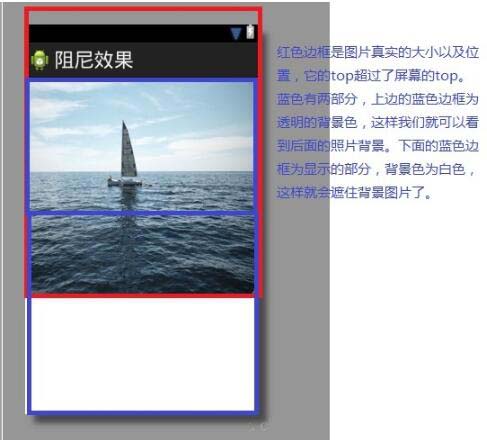OS的下拉上拉都会出现一个很玄的动态效果。在Android中,虽然可以实现类似的效果,但有点不同的是,如果调用overScrollBy来实现类似的阻尼效应的话,最顶部会出现一片亮的区域,让人感觉不是很爽。所以决定不采用该方法来实现而是改用自定义的方式来实现。
下面是自定义控件的代码部分:

public class MyView extends ScrollView {
//记录下最开始点击的位置
int initY;
//移动的位置
int deltaY;
int touchY;
//记录第一个item的位置的矩形
Rect topRect;
//用来存放第一个可见的item
View inner;
//记录下ImageView最原始的顶部位置和底部位置
int initTop,initButtom;
int left = 0,top = 0,right = 0,bottom = 0;
ImageView imageView;
State state;
boolean recordFlag;
enum State
{
UP,NORMAL,DOWN
}
boolean isMoving;
boolean shutScroll;
private int current_Bottom;
private int current_Top;
public MyView(Context context, AttributeSet attrs) {
super(context, attrs);
state = State.NORMAL;
topRect=new Rect();
recordFlag=false;
}
public void setImageView(ImageView imageView)
{
this.imageView=imageView;
}
//当布局加载完成之后调用该方法
@Override
protected void onFinishInflate() {
super.onFinishInflate();
//返回加载完成后所看到的第一个item,这里就是看到的第一个item,通过对该对象的移动来实现整体的移动
inner=getChildAt(0);
Log.i("inner", inner.toString());
}
//onTouchEvent的返回值 返回true的话表示该事件已经被处理了,返回false表示改时间还未被处理
@Override
public boolean onTouchEvent(MotionEvent ev) {
if(inner!=null)
{
commOnTouchEvent(ev);
}
if(shutScroll)
{
return true;
}else
{
return super.onTouchEvent(ev);
}
}
private void commOnTouchEvent(MotionEvent ev) {
switch(ev.getAction())
{
case MotionEvent.ACTION_DOWN:
{
if(recordFlag==false)
{
left=inner.getLeft();
top=inner.getTop();
right=inner.getRight();
bottom=inner.getBottom();
recordFlag=true;
}
//开始的时候接触点的坐标值
initY=(int) ev.getY();
//记录下ImageView的原始高度
initTop=imageView.getTop();
//记录下ImageView的原始的底部的像素坐标
initButtom=imageView.getBottom();
break;
}
case MotionEvent.ACTION_MOVE:
{
//滑动的距离
deltaY=(int) (ev.getY()-initY);
if(deltaY<0)
{
//向上滑动
state=State.UP;
isMoving=false;
shutScroll=false;
}
else if(deltaY>=0)
{
//在这里做一下判断,当getScrollY为0时,继续下拉就会进入down状态。
if(getScrollY()==0)
{
//向下滑动
state=State.DOWN;
isMoving=true;
shutScroll=true;
}
}
if(isMoving)
{
if (topRect.isEmpty()) {
// 保存正常的布局位置
topRect.set(left, top,right,bottom);
}
float inner_move_H = deltaY / 5;
inner.layout(topRect.left, (int) (topRect.top + inner_move_H),
topRect.right, (int) (topRect.bottom + inner_move_H));
float image_move_H = deltaY / 10;
current_Top = (int) (initTop + image_move_H);
current_Bottom = (int) (initButtom + image_move_H);
imageView.layout(imageView.getLeft(), current_Top,
imageView.getRight(), current_Bottom);
}
break;
}
case MotionEvent.ACTION_UP:
{
if(needToScroll())
{
animation();
}
if(getScrollY()==0)
{
/*这里为什么要这么写呢?这里有很重要的一个知识点:
* getScrollY()返回的是手机屏幕左上角和调用该方法的view的左上角之间的Y坐标只差。
* 在这里,自定义空间的布局方式看看布局文件就会发现,当View滑动的时候,View的状态在up,normal;
* down之间切换。在View下来的过程中,normal和down有一个临界值,这个临界值就是该view的
* 左上角是不是和屏幕的左上角相等。相等的话就说明再向下拉的话就down状态了。*/
state=State.NORMAL;
}
break;
}
}
}
private void animation() {
//背景图片平移的动画
TranslateAnimation image_Anim = new TranslateAnimation(0, 0,
Math.abs(initTop - current_Top), 0);
image_Anim.setDuration(200);
imageView.startAnimation(image_Anim);
imageView.layout(imageView.getLeft(), (int) initTop,
imageView.getRight(), (int) initButtom);
// 开启移动动画
TranslateAnimation inner_Anim = new TranslateAnimation(0, 0,
inner.getTop(), topRect.top);
inner_Anim.setDuration(200);
inner.startAnimation(inner_Anim);
inner.layout(topRect.left, topRect.top, topRect.right, topRect.bottom);
//state=State.NORMAL;
topRect.setEmpty();
}
private boolean needToScroll() {
if(state==State.DOWN)
{
return true;
}
return false;
}
}
以上这篇Android实现简单的下拉阻尼效应示例代码就是小编分享给大家的全部内容了,希望能给大家一个参考,也希望大家多多支持。